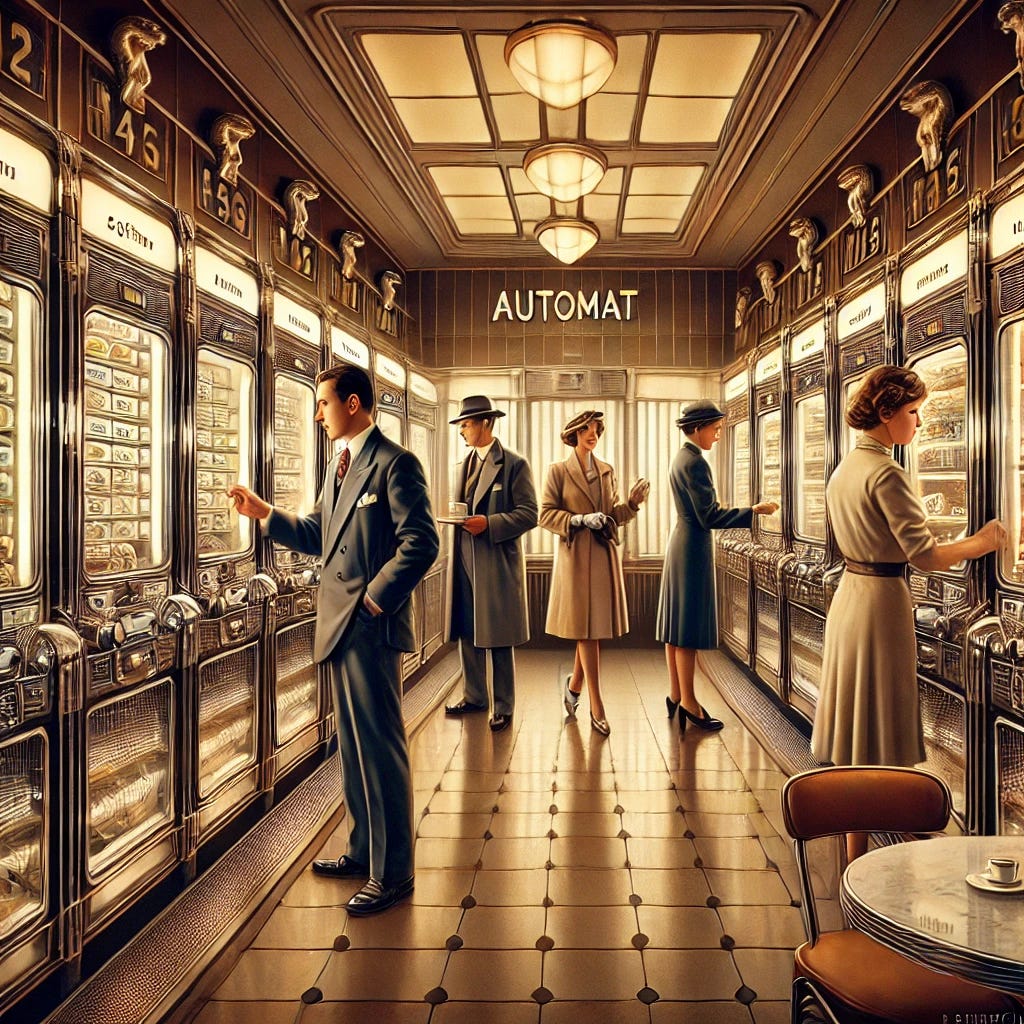From Slots to Apps: How the Automat Changed How America Eats
New York City, 1939: A businessman drops his last nickel into a slot, turns a chrome knob, and retrieves a steaming cup of coffee from behind a small glass door. Next to him, a secretary selects a slice of lemon meringue pie. Across the marble table, a construction worker enjoys mac and cheese that cost him just a few coins. No waiters hover, no cashiers impatiently waiting for their selections. In a city of stark social divides, the automat was a great equalizer – a democratic dining experience delivered through mechanical innovation.
European Roots to American Innovation
The automat concept began in 1890s Berlin, where "Quisisana Automats" offered simple foods through coin-operated windows. These early European versions focused primarily on snacks and drinks, popular novelties in a continent fascinated by mechanical innovation. But it took two American entrepreneurs to transform this concept from curiosity to cultural institution.
Joseph Horn and Frank Hardart opened their first Philadelphia restaurant in 1888, but it was their 1902 decision to import the automat concept that revolutionized their business. When they expanded to New York in 1912, they didn't just replicate the European model – they reinvented it as a full dining experience.
A Business Model Built on Volume
The automat's success wasn't just about its delivery mechanism but its underlying business model. Horn & Hardart operated on remarkably thin margins, making pennies on each transaction but serving thousands of customers daily. Their profit depended on high volume, rapid turnover, and central commissaries that supplied multiple locations with standardized food items – a forerunner to the fast-food supply chains that would later replace them.
Their financial strategy prioritized operational efficiency while maintaining food quality. By eliminating waitstaff, they reduced labor costs and redirected resources to food production. The coin-operated system also eliminated cash handling errors and theft, while providing immediate payment.
The central commissary system – revolutionary for its time – allowed for bulk purchasing, standardized preparation, and quality control across all locations. At their peak in the 1940s and 50s, Horn & Hardart operated over 40 automats in New York City alone, serving more than 800,000 people daily.
Democratic Dining
What truly distinguished automats was their fundamental democracy. A Wall Street banker might sit next to a factory worker on lunch break. A woman could dine alone without raising eyebrows – a rarity in early 20th century restaurants. There were no waiters to tip, no language barriers to navigate, no social codes to master.
During the Great Depression, this accessibility became even more significant. Horn & Hardart's five-cent coffee and affordable sandwiches provided nourishment that crossed economic divides. When customers began filling up on free condiments, the company largely looked the other way, recognizing their role in feeding a struggling city.
Quality Behind the Chrome
The real innovation of Horn & Hardart lay behind those gleaming doors. Their coffee – dispensed from iconic dolphin-headed spouts – was prepared using a patented water filtration system that predated today's third-wave coffee obsession. Beans were roasted in-house, ground within two hours of brewing, and no pot was allowed to sit for more than 20 minutes. At their peak, they sold over 90 million cups annually.
The company's commitment to quality extended throughout their menu. Pies were baked fresh daily. Breads came from in-house bakeries. The famous mac and cheese was made with sharp cheddar when most Americans still considered processed cheese a luxury. In marrying mechanical efficiency with culinary standards, Horn & Hardart created something novel: fast food that was actually good food.
The Beginning of the End
By the late 1950s, the forces that had made automats successful began to reverse. Suburbanization meant fewer downtown workers. Fast food chains offered drive-through service for a newly car-centered culture. Rising food and real estate costs squeezed their thin margins, forcing quality compromises that eroded customer loyalty.
The final blow came from inflation. The coin-operated system that had once seemed so modern became a liability. As prices rose beyond what a few coins could cover, customers needed to make multiple trips to the change booth for a single meal. When Horn & Hardart finally introduced dollar bill changers in the 1970s, it was too little, too late. The last New York automat closed in 1991, ending a remarkable 90-year run.
Digital Descendants
Today's ghost kitchens, delivery apps, and ordering kiosks share DNA with the automat, though few acknowledge their mechanical ancestor. Both models separate food production from customer interaction. Both prioritize efficiency and standardization. Both use technology to reduce labor costs while maintaining food quality.
The COVID-19 pandemic accelerated this trend toward contactless dining with QR codes replacing servers and new types of vending machines making everything from pizza to a steaming macchiato.
The Legacy of the Slot
The rise and fall of the automat reveals something important about innovation: technological novelty alone doesn't sustain a business. Horn & Hardart thrived for decades because their system served genuine human needs – for efficiency, affordability, quality, and social dignity – not just because it was novel.
Today's food tech companies might learn from this legacy. The automat didn't just feed people; it created a space where all were welcome, good food was accessible, and mechanical precision served human connection. Perhaps that's why its chrome-and-glass image still captures our imagination, nearly a century after that first nickel dropped.
Stay tuned.




